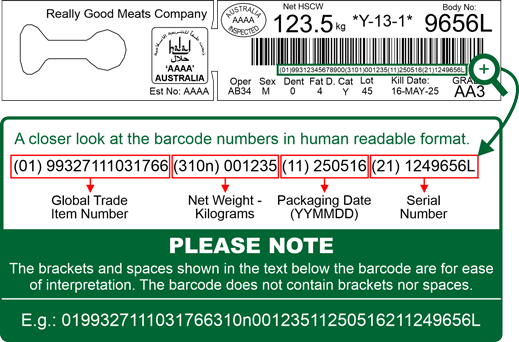| Standard: | Carcase Tickets (barcodes) | ||||||||||||||||||||||||||||||||||||||||||||||||||||||||||||||||||||||||||||||||||||||||||||||||||||||||||||||
|---|---|---|---|---|---|---|---|---|---|---|---|---|---|---|---|---|---|---|---|---|---|---|---|---|---|---|---|---|---|---|---|---|---|---|---|---|---|---|---|---|---|---|---|---|---|---|---|---|---|---|---|---|---|---|---|---|---|---|---|---|---|---|---|---|---|---|---|---|---|---|---|---|---|---|---|---|---|---|---|---|---|---|---|---|---|---|---|---|---|---|---|---|---|---|---|---|---|---|---|---|---|---|---|---|---|---|---|---|---|---|---|
| Status: | Released | ||||||||||||||||||||||||||||||||||||||||||||||||||||||||||||||||||||||||||||||||||||||||||||||||||||||||||||||
| Issue date: | Oct 2005 | ||||||||||||||||||||||||||||||||||||||||||||||||||||||||||||||||||||||||||||||||||||||||||||||||||||||||||||||
| Endorsement: | Australian Meat Industry Language and Standards Committee, AUS-MEAT, GS1 | ||||||||||||||||||||||||||||||||||||||||||||||||||||||||||||||||||||||||||||||||||||||||||||||||||||||||||||||
| Purpose: |
The purpose of this standard is to define a consistent supply chain approach to the numbers and barcodes applied to carcase tickets for ease of barcode scanning and data interoperability along the red meat supply chain. The overall objective is to ensure that each participant along the red meat supply chain can easily extract the trade information about a carcase of meat. Each carcase ticket is assigned a barcode following the GS1 standards. This is to ensure that each carcase ticket is barcoded with a globally unique number that provides the basis for traceability along the whole supply chain. For more information on the GS1 standards go to: gs1.org |
||||||||||||||||||||||||||||||||||||||||||||||||||||||||||||||||||||||||||||||||||||||||||||||||||||||||||||||
| Scope: |
This RMSCC Supply Chain Information Standard is a voluntary red meat industry standard. The use of this standard may be a commercial requirement for certain supply chains and may be required for participation in certain industry programs such as Meat Messaging. The RMSCC Supply Chain Information Standard is limited to carcase and carcase portions for non-retail trade. The carcase and carcase portions of non-retail trade products are intended for domestic and international export supply chains. The packaging of carcase and carcase portions of non-retail trade products include exposed as well as wrapped carcase and carcase portions. All carcase and carcase portions of non-retail trade products will be ticketed with a suitable market compliant trade ticket (compliant to trade descriptions and AUS-MEAT National Accreditation Standards requirements) including a GS1-128 barcode with the information and encoding defined in this standard. |
||||||||||||||||||||||||||||||||||||||||||||||||||||||||||||||||||||||||||||||||||||||||||||||||||||||||||||||
| References: |
AUS-MEAT trade descriptions and AUS-MEAT National Accreditation Standards requirements, GS1 GTIN standards, GS1 Application identifiers. |
||||||||||||||||||||||||||||||||||||||||||||||||||||||||||||||||||||||||||||||||||||||||||||||||||||||||||||||
| Details: |
Barcode Symbology The Barcode symbology used in the Australian Red Meat Industry Standard Variable Weight Carcase Label is GS1-128. The GS1-128 barcode allows secondary attribute information over and above primary item identification to be represented in the barcode. Application Identifiers (AIs) effectively act as prefixes for this information and define the meaning and structure of the embedded data which follows. AIs allow you to represent attribute information such as weight, slaughter date and serial numbers in a standard format. This ensures that the attribute information encoded by one company can also be scanned and interpreted by any other company in the supply chain. Concatenation Concatenation (stringing AIs together) is an effective means for presenting multiple element strings in a single GS1-128 Barcode Symbol and should be used to conserve space and optimise scanning operations. Maximum Length When concatenating AIs, the maximum number of characters in the GS1-128 Barcode Symbol must not exceed 48. This includes Function Code 1 (FNC1) when used as a field separator but excludes auxiliary characters and the Symbol Check Character (Modulo 103). The length of the GS1-128 Barcode Symbol must never exceed 165mm, including the Quiet Zones (light margins). Barcode Data including Application Identifiers (AIs)
Magnification The size of the GS1-128 Barcode Symbol depends on:
For the meat industry it was determined that it would be primarily a hand scanning requirement. The allowable X-dimension range is 0.25mm to 0.495mm (magnifications between 25% and 48.7%). For GS1-128 barcode symbols that are to be scanned in a General Distribution Environment (primarily automated scanning). The allowable X-dimension range is 0.495mm to 1.02mm (magnifications between 48.7% and 100%). Height of Bars The minimum bar height is 13mm. For scanning in a General Distribution (automated scanning) environment, the minimum bar height for a GS1-128 Barcode Symbol is 32mm. Human Readable Interpretation Print the Human Readable Interpretation either above or below the symbol bars. Make sure the Application Identifiers (AIs) are clearly recognisable by placing them in brackets in the Human Readable Interpretation only. GS1-128 Symbol Dimensions
|
||||||||||||||||||||||||||||||||||||||||||||||||||||||||||||||||||||||||||||||||||||||||||||||||||||||||||||||
| Comments and Feedback: |
Comments and feedback about this standard are sort from industry. This includes any requests for any enhancements or changes. Any submitted comments, feedback or change requests are reviewed by the Work Group following the RMSCC Core Principles and the RMSCC Standards Development model. To submit comments, feedback or change requests click on this link: RMSCC Feedback and Change Requests. |
||||||||||||||||||||||||||||||||||||||||||||||||||||||||||||||||||||||||||||||||||||||||||||||||||||||||||||||
| Further information: |
GS1 Australia in conjunction with meat industry representatives including, MLA, AUS-MEAT, AQIS and AMIC developed a set of numbering and bar-coding guidelines for the Australian Red Meat Industry. A copy of the guidelines or for further assistance on meat industry bar coding please contact GS1 Australia on 1300 227 263 or visiting gs1au.org |
||||||||||||||||||||||||||||||||||||||||||||||||||||||||||||||||||||||||||||||||||||||||||||||||||||||||||||||
